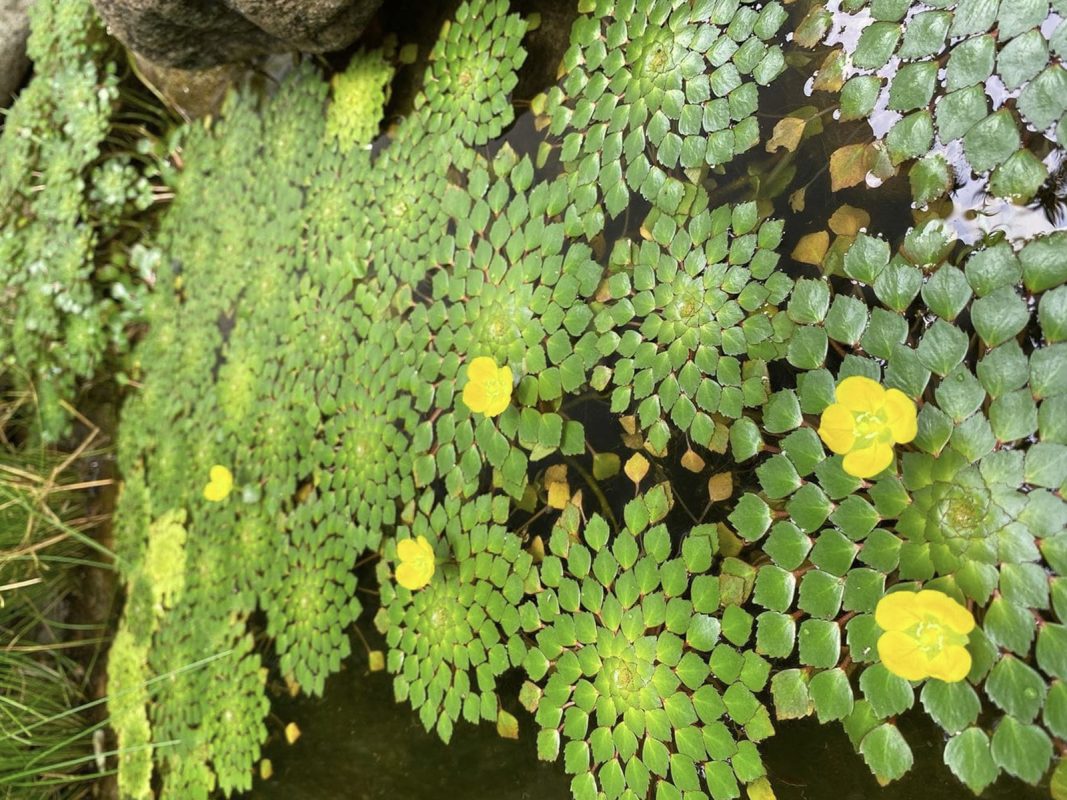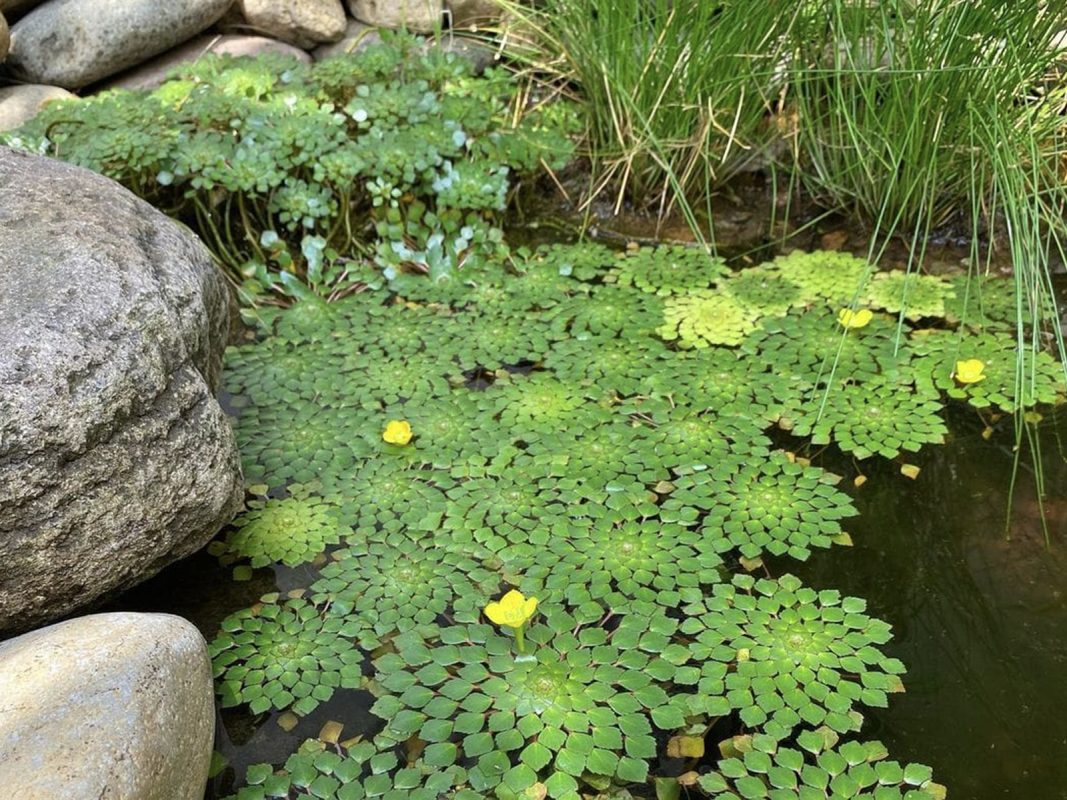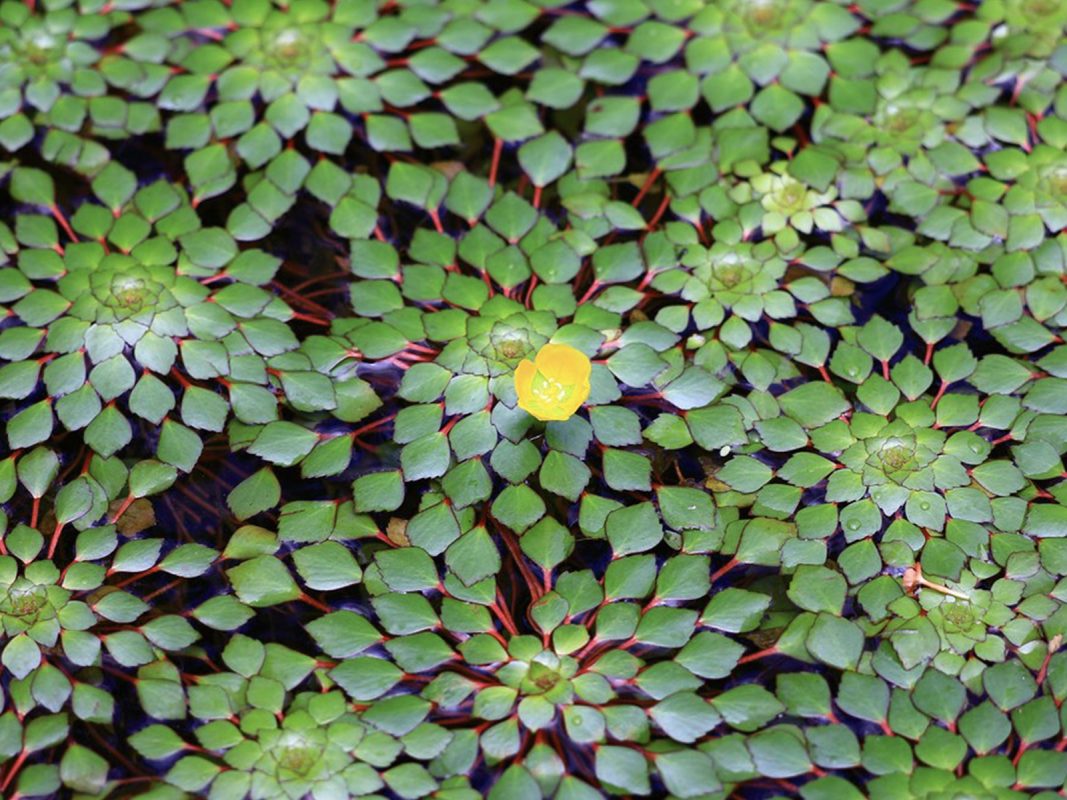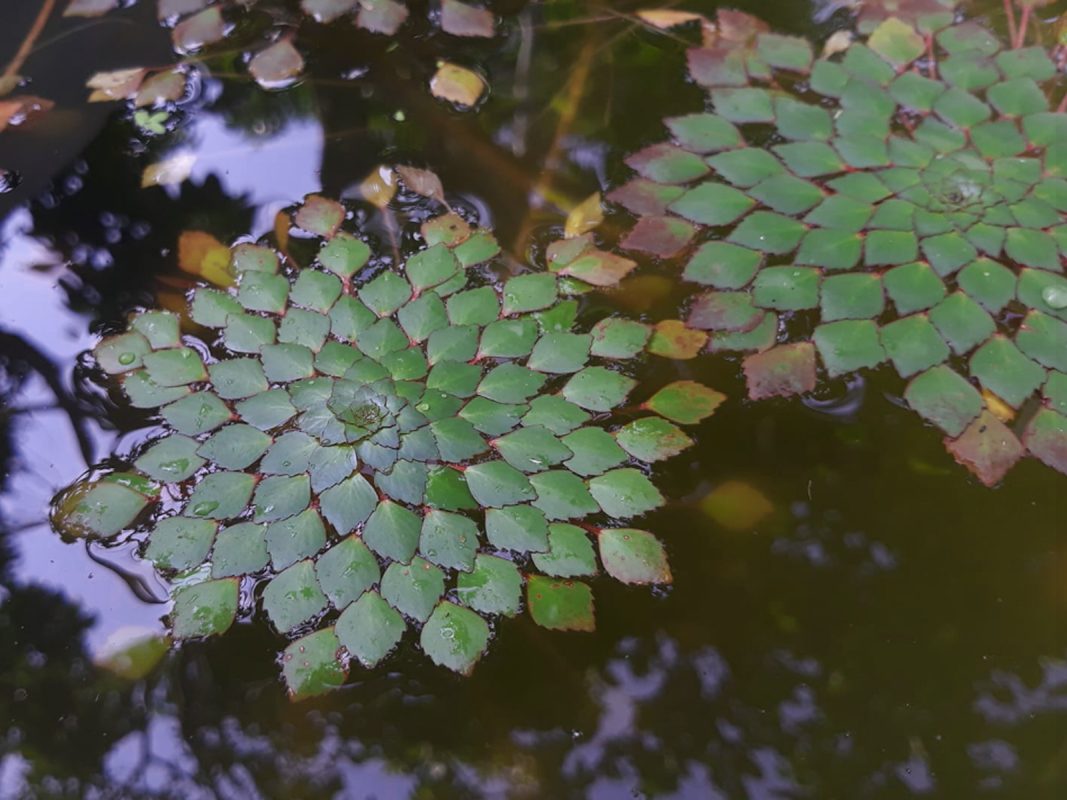Blogs
Mosaic Plant(Ludwigia Sedioides) – Aquatic Plant
The mosaic plant, scientifically known as Ludwigia sedioides, is a captivating aquatic perennial that enchants with its vivid green and reddish-brown foliage, resembling the stunning patterns of a mosaic itself. Often found flourishing in quiet ponds and marshes, this plant has gained popularity among aquatic plant enthusiasts and landscape designers alike. Its unique visuals create serene beauty in water gardens, while its ecological benefits contribute positively to aquatic environments. Caring for the mosaic plant, however, involves understanding its specific requirements in terms of planting, propagation, growth conditions, and maintenance practices. Fortunately, with the right knowledge and attention, it can flourish, transforming any water feature into a visual oasis.
In this comprehensive care guide, we delve into all aspects of nurturing Ludwigia sedioides from optimal planting conditions and propagation techniques to tailored maintenance practices and troubleshooting common issues. Whether you’re a novice plant keeper looking to add color to your water garden or a seasoned horticulturist wanting to enhance your aquatic landscape, this guide aims to equip you with the insights needed to enjoy the aesthetic and ecological advantages of the mosaic plant fully. Let’s dive into the natural beauty of Ludwigia sedioides and explore how to cultivate and maintain its splendid presence.
Planting and Propagation
When embarking on the journey to plant and propagate Ludwigia sedioides, understanding the right substrates and methods ensures a healthy start for this remarkable aquatic plant. First and foremost, when planting this species, it thrives best in nutrient-rich substrates developed for aquatic plants. Whether you use fine-grained soil or clay, it’s crucial to ensure that the substrate is packed with organic nutrients to support the plant’s growth.
Best Soil and Substrate for Mosaic Plant
As a robust grower, Ludwigia sedioides prefers a rich, nutrient-dense environment to develop its striking foliage. The ideal substrate consists of silt or clay adorned with high organic matter, promoting excellent root establishment and supporting the vigorous growth that this species is known for. When selecting soil, ensure it is fine-grained to provide the necessary aeration, helping the plant’s roots breathe and absorb nutrients efficiently.
Here’s a comparative look at some recommended substrate choices for optimal growth:
| Substrate Type | Nutrient Content | Drainage | Ideal Use Case |
|---|---|---|---|
| Silt | High | Moderate | Ponds and shallow areas |
| Clay | Very High | Low | Artistic containers or deeper ponds |
| Aquatic Substrate | Moderate | Moderate | Versatile despite depth |
| Pebbles | Low | High | Decorative but not ideal for growth |
Employing a nutrient-rich substrate and incorporating fertilizer tablets below the roots can further enhance growth. Positioning these tablets strategically will ensure essential nutrients are readily available as the plant’s roots expand. When planted under such favorable conditions, Ludwigia sedioides will exhibit its rich green foliage with distinct reddish accents, symbolizing the beauty of life in aquatic systems.
How to Plant Ludwigia Sedioides

Planting Ludwigia sedioides can be a straightforward process if conducted with care and attention to its specific requirements. Begin by selecting a location with appropriate water depth, ideally between 12 to 24 inches (30 to 60 cm). This depth allows the stems of the plant to reach the surface and spread out across the water, creating that lovely mosaic-like effect that characterizes this aquatic species.
To plant, simply insert the stem gently into the substrate while ensuring it’s securely anchored. This is crucial as loose anchoring may result in the plant floating away. If you prefer to propagate your mosaic plant, stem cuttings are a viable method. The cuttings can either be placed to float quietly atop the water surface, or you can choose to submerge them in the right substrate, which nurtures the roots effectively. In doing this, users need to remain patient and vigilant, allowing roots to develop properly, ultimately leading to thriving foliage above water.
Common Propagation Methods
Propagation of Ludwigia sedioides primarily revolves around stem cuttings, a technique appreciated for its simplicity and effectiveness. To propagate, select healthy stems from the existing plant, ideally those that exhibit lush foliage. Gently cut these stems at approximately 4 to 6 inches in length. If these cuttings are to float, they need to be placed carefully in calm waters, avoiding strong currents or waves that could dislodge them.
Another effective method is to place these cuttings in an aquatic planting basket filled with nutrient-rich substrate, submerging them up to their crowns for steady growth. It’s important to maintain appropriate water levels for the cuttings to successfully root. Typically, floating propagation works best in shallower water, while basket methods offer more stability.
Optimal Water Depth During Planting
The mosaic plant prefers water depths between 12 to 24 inches, striking a balance that allows for both aeration and light penetration. Planting at this depth further encourages healthy growth, since it provides the plant with enough buoyancy to push its stems and leaves to the surface and spread outward. This growth is crucial for the distinctive look that the mosaic plant is known for. If the water depth is too shallow, it can hinder growth potential, while too deep of water might suffocate the roots.
Moreover, be mindful of variations in water levels during seasonal shifts, fluctuations that could impact the plant’s health. Strive to maintain the ideal depth consistently for the best results year-round.
Tips for Successful Rooting
Successfully rooting Ludwigia sedioides often relies on a few key care strategies. First, patience is paramount. Monitor the cuttings over a few weeks to observe root development. You can provided a boost by using a high-quality aquatic fertilizer during this time, applying it in moderation to avoid nutrient overload.
Second, ensure the water temperature remains relatively stable and warm, ideally between 70-80°F (21-27°C), avoiding drastic temperature fluctuations that could shock the plant. Lastly, keeping the sunlight exposure consistent ideally 12 hours of light per day encourages vibrant growth as it enhances photosynthesis, further nurturing new roots.
Growing Conditions
Creating the right environment for Ludwigia sedioides is crucial to its thriving state. This aquatic plant has specific requirements concerning temperature, light, and water quality, playing pivotal roles in its growth and aesthetic appeal. Understanding these nature-driven needs can only pave the way for lush foliage and vibrant colors.

Ideal Temperature Range
A significant factor in the care of Ludwigia sedioides is ensuring a stable temperature range. The plant flourishes when maintained in temperatures between 70°F to 80°F (21°C to 27°C). Exposure to temperatures below 65°F (18.3°C) can lead to stress, characterized by yellowing leaves and stunted growth, and beyond this, prolonged exposure could lead to the plant’s demise.
To achieve the ideal temperature, especially in colder climates, consider utilizing heaters for your pond or aquarium, which can help maintain a comfortable environment. This proactive approach needs to be constant, allowing the plant to flourish and achieve its beautiful coloration.
Light Requirements and Placement
For thriving foliage, Ludwigia sedioides requires full sun to partial shade. Optimal growth occurs under direct sunlight, ideally ranging from 8 to 12 hours daily. Providing ample sunlight not only energizes the plant but also helps in developing the vivid coloration of its leaves, showcasing that stunning contrast between greens and reds.
When positioning the plant, place it in locations where it receives unobstructed light, such as the edges of water bodies that enjoy both sunlight and shade. However, be cautious of excessive shade, which could impede growth. Investing in durable lighting systems, if necessary, allows for enhanced light penetration, especially in deeper water settings.
Water Quality and pH Levels
Maintaining optimal water quality is paramount for the healthy growth of Ludwigia sedioides. This plant thrives in slightly acidic water, ideally with a pH level between 5.5 to 7.5. If the water pH rises above 8, the health and growth of the plant might start to decline, indicating the necessity for adjustments. Implementing tests for water quality can help in monitoring parameters that influence overall plant health.
In addition to pH, ensure that the water remains free from pollutants and toxins, as these could adversely affect the roots and foliage. Regular testing and treatment of water parameters will promote propitious growth and maintain the plant’s striking aesthetic.
Nutrient Requirements for Healthy Growth
To ensure that Ludwigia sedioides maintains its lush appearance, offering adequate nutrients is essential. A nutrient-rich environment, with nitrogen, phosphorus, and potassium, supports robust root development and vibrant foliage. Using quality fertilizers developed for aquatic plants can be invaluable. Incorporating these into the substrate or water will provide the necessary nutrients to encourage healthy growth.
Routine monitoring of nutrient levels and making thoughtful adjustments based on the plant’s response is crucial. Consequently, understanding your plant’s specific needs based on season or growth stage can help achieve optimal health and aesthetic success.
Seasonal Growth Patterns
Understanding the seasonal growth patterns of Ludwigia sedioides is essential for successful cultivation. Typically, these plants exhibit vigorous growth during spring and summer, with growth rates averaging about 1 foot per month in favorable environmental conditions. Their health significantly depends on managed environmental factors, including temperature and light.
When temperatures drop in winter, however, growth may stagnate particularly in colder regions where freezing conditions could even lead to total dieback. In such areas, successful overwintering strategies are necessary for surviving the cold months and enabling them to thrive again come spring.
Maintenance Practices
When it comes to maintaining Ludwigia sedioides, establishing a timeline of care practices ensures that this vibrant plant continues to flourish. From a consistent watering schedule to appropriate pruning techniques, understanding these maintenance practices is key to a healthy aquatic ecosystem.

Watering Schedule and Frequency
As an aquatic plant, Ludwigia sedioides does not require traditional watering, but sustaining consistent water levels is critical for its growth. When planted in a pond, ensure that water levels are maintained, avoiding excessive evaporation or pooling from heavy rains. Regular monitoring is important, particularly during the summer months when water levels can drop significantly.
Moreover, ensure that the water remains clean and devoid of pollutants, as this can impact the health of the plant and the surrounding aquatic ecosystem. Incorporating a filtration system can assist in purifying water and maintaining suitable levels for your flourishing mosaic plant.
Fertilization Tips for Aquatic Plants
Fertilizing Ludwigia sedioides can significantly boost growth and overall health, making it vibrant and lush. Upon planting, place a fertilizer tablet just below the roots, ensuring that it is well-integrated with the substrate. This proactive approach allows nutrients to reach the plant roots effectively.
If the plant is floating on water, additional fertilizers might not be necessary. However, should you observe stunted growth or color changes, consider employing liquid fertilizers specifically designed for aquatic plants to facilitate further nutrient absorption.
Pruning and Trimming Techniques
Maintaining the health of Ludwigia sedioides often involves regular pruning and trimming. Engage in periodic management to remove dead or dying foliage, as well as flower debris. This not only rejuvenates the plant but also encourages ongoing growth and development.
Some key pruning techniques include:
- Crown thinning to enhance air circulation
- Deadheading to foster continuous bloom
- Thinning cuts to maintain balanced growth
- Heading cuts to stimulate new growth
Successful pruning minimizes stress on the plant and reduces disease risk, benefiting your aquatic landscape significantly.
Pest and Disease Management
Pests and diseases can threaten the health of Ludwigia sedioides. Effective management practices include regular inspection of the plant for signs of infestations. Early detection is crucial; remove affected areas promptly to prevent further spread.
Improving air circulation through judicious pruning can also mitigate many diseases. Sterilizing pruning tools between cuts helps prevent disease transmission, while selecting disease-resistant varieties when possible can add an extra layer of protection against potential issues.
Overwintering Strategies for Non-Tropical Regions
For regions that experience frigid winters, implementing effective overwintering strategies can lead to the sustained health of Ludwigia sedioides. Key strategies should include:
- Pruning in late winter, removing dead or damaged wood
- Mulching around the base to retain soil warmth
- Covering tender plants to protect from frost exposure
- Bringing containerized plants indoors or positioning them in sheltered spots
By following these guidelines, Ludwigia sedioides will have a better chance of thriving during the warmer months upon its return in spring.
Landscape Uses
Incorporating Ludwigia sedioides into landscape design offers aesthetic and ecological benefits. This striking aquatic plant can be utilized in a range of contexts, from water gardens to ponds, enhancing the beauty of any outdoor space.

Incorporating Mosaic Plant in Water Gardens
One of the most captivating uses for Ludwigia sedioides involves integrating it within water gardens. Its rosette-like foliage can serve as a focal point, adding vibrant color and texture to shallow waters. Placing the plant around the edges at depths of between 6 to 12 inches allows it to flourish.
Be sure to provide full sun exposure, ensuring healthy growth. Pairing this beauty with other aquatic plants can create a layered, textured atmosphere that perfectly complements the serene essence of water features.
Benefits for Aquatic Ecosystems
The presence of Ludwigia sedioides in aquatic ecosystems offers numerous advantages. The plant contributes to oxygen production, enhances water quality by absorbing excess nutrients, and aids in stabilizing pond banks preventing erosion.
Additionally, this enchanting plant provides habitat and shelter for fish and other aquatic life. Moreover, its presence attracts wildlife, fostering a healthy environment that encourages biodiversity in your garden oasis.
Design Ideas for Ponds and Streams
Designing a pond or stream around Ludwigia sedioides involves utilizing creative elements for visual impact. Introducing a variety of features like fountains or bubbling stones provides auditory charm, while incorporating diverse aquatic plants creates intrigue.
Strategically position Ludwigia sedioides and other plants to frame views, highlighting focal points within the landscape, while employing natural elements such as rocks or driftwood will help unify the overall aesthetic appeal.
Compatibility with Other Aquatic Plants
Maintaining compatibility with other aquatic plants is crucial in fostering a balanced ecosystem. Combining several types of aquatic species such as floating, submerged, and marginal plants enriches the biodiversity present in water gardens.
Choose plants with similar light and nutrient requirements to ensure they thrive together, and provide adequate spacing between each species to promote healthy growth and proper water circulation.
Aesthetic Appeal in Outdoor Spaces
The aesthetic appeal of Ludwigia sedioides can transform gardens into picturesque sanctuaries. With stunning foliage, this plant not only enhances visual interest but can also inspire tranquility in outdoor spaces. Combine vibrant low-maintenance plants, anchoring their roots in water while allowing the floating leaves to dance gracefully in the wind.
Using contrasting colors and textures, you can create a diverse landscape that draws the eye and soothes the spirit, bringing a touch of tropical elegance to your home.
Troubleshooting Common Issues
Though Ludwigia sedioides is generally hardy, it may face various challenges. Understanding common issues and their indicators will prepare you for effective troubleshooting and care.
Signs of Stress in Ludwigia Sedioides
Identifying stress signs in Ludwigia sedioides is paramount for reversing potential damage. Common stress indicators include yellowing leaves, wilting stems, or a lack of new growth. If the leaves are falling off during handling, it may signify environmental stressors or improper care.
Watching for sudden changes in the plant’s vibrancy can be the first step in adjusting care effectively. Taking white balance into account during photography can also aid in accurately identifying color shifts that may not be readily visible to the naked eye.
Solutions for Cold Temperature Damage
In regions experiencing chilly temperatures, Ludwigia sedioides can struggle. Ice-cold conditions can lead to limb and root damage, yielding problematic growth. If the water temperature drops significantly below 70°F (21°C), the plant is at risk.
To mitigate these issues, consider using pond heaters, especially during frost warnings. If the plant shows signs of decline, corrective measures should be prioritized to return it to a thriving condition before spring blooms.
Managing Excessive Growth and Spread
Recognizing the fast growth rate of Ludwigia sedioides sometimes reaching 1 foot per month leads to proactive management techniques. Overpopulation in a confined area can pose challenges to maintaining water quality and limiting plant spread.
When planning your aquatic garden, be prepared to conduct routine pruning to manage growth, particularly in warmer climates where temperature remains stable. Using underwater baskets can help contain the plant while still allowing roots to flourish.
Addressing Leaf Spot and Other Diseases
Although Ludwigia sedioides is relatively resistant to diseases, outbreaks may happen, including leaf spot. Identifying issues as early as possible is crucial; remove affected foliage immediately and maintain good water quality. Regular inspections will ensure that your plant remains healthy, thriving, and beautiful.
When to Seek Professional Help
If the plant’s condition continues to deteriorate, it may be time to consult a specialist. Whether for comprehensive management advice, assistance with invasive spreading, or guidance with overwintering, expert support can provide invaluable insights to maintain a thriving aquatic plant community.
By nurturing Ludwigia sedioides and conducting proper care, you can create an enchanting aquatic environment that remains vibrant through the seasons, enriching not just your garden, but the surrounding ecosystem as well.

